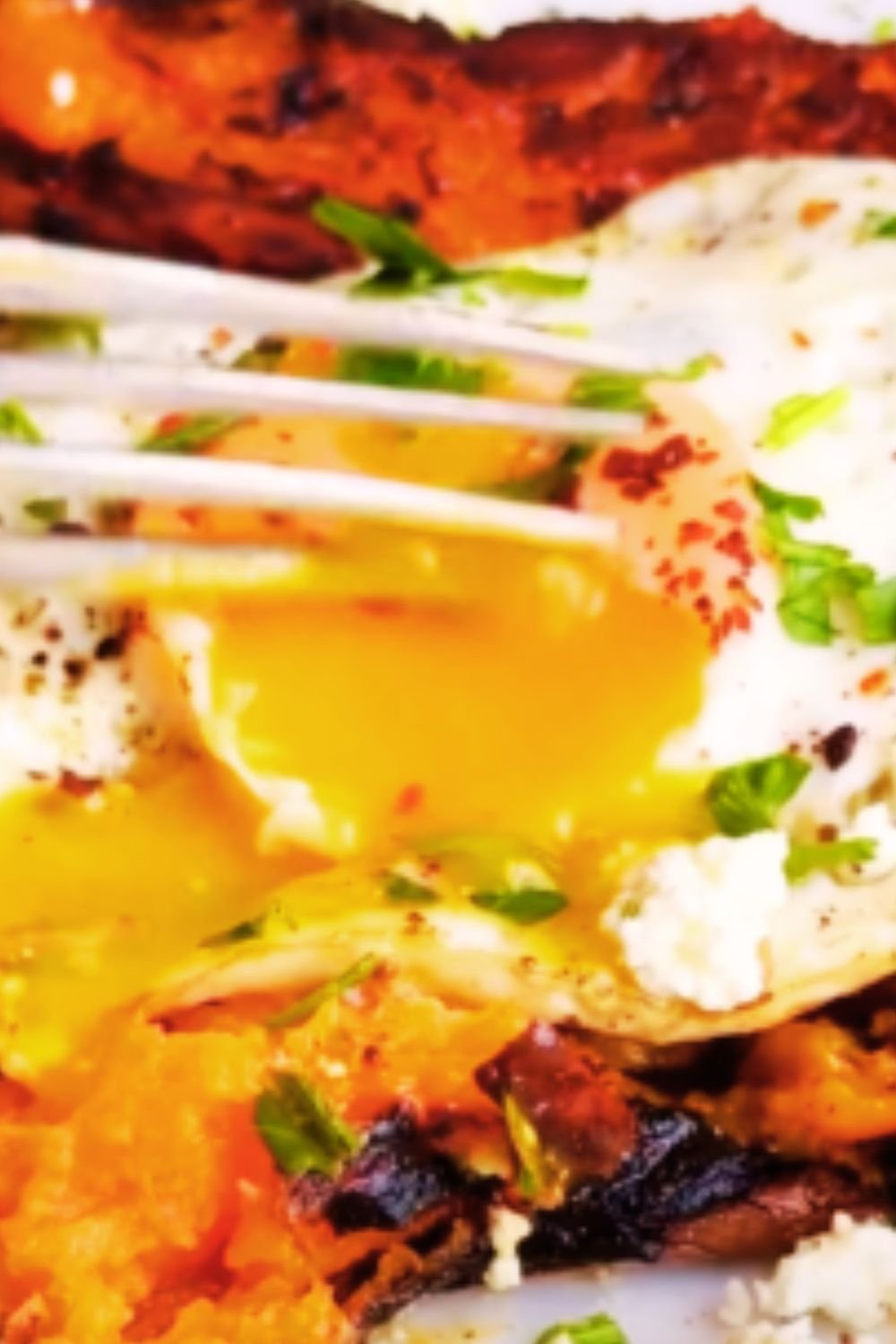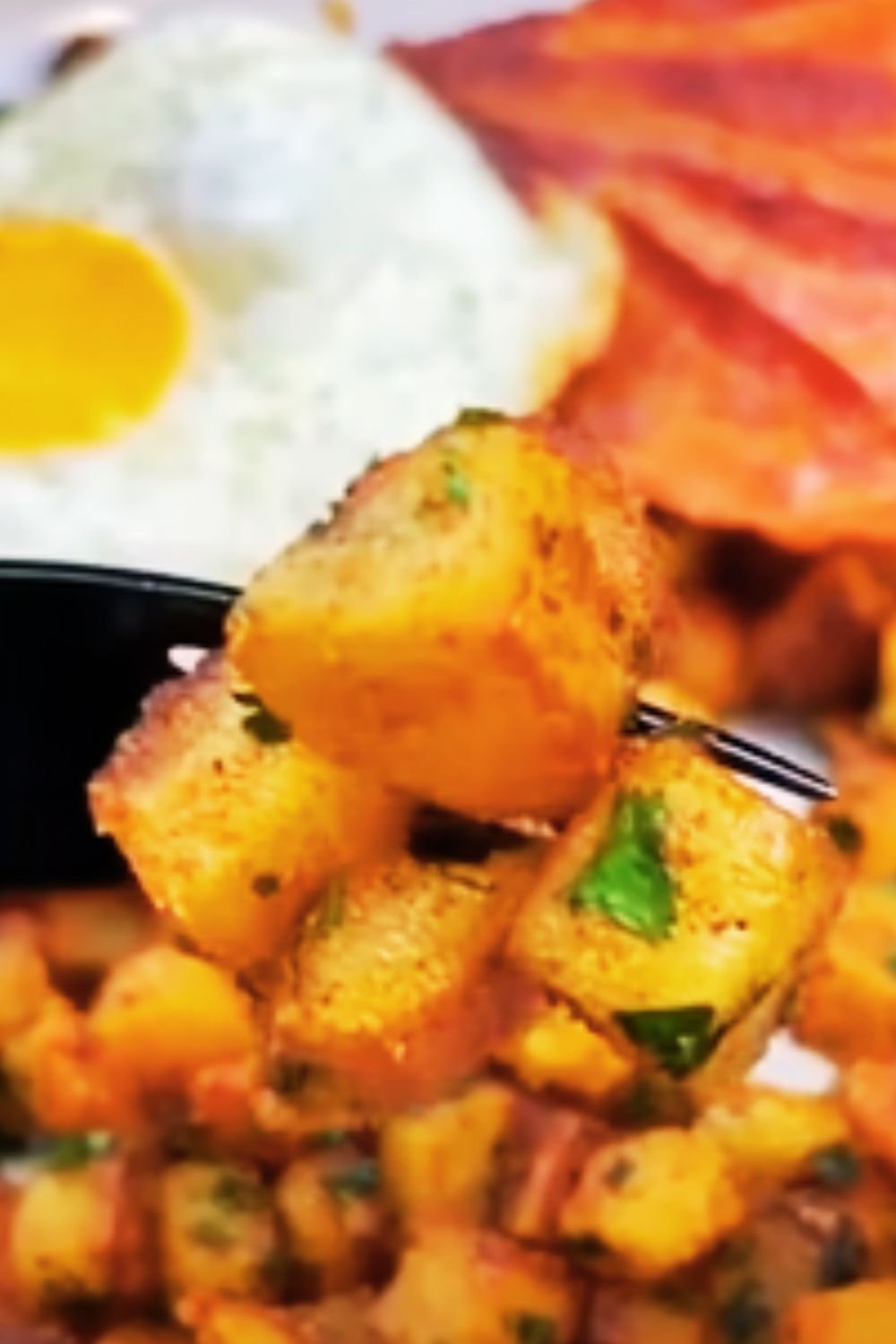There’s something magical about a well-executed breakfast skillet. That perfect harmony of flavors coming together in one pan, creating a symphony of textures and tastes that dance across your palate. Today, I’m sharing one of my absolute favorite morning creations: a Chorizo & Sweet Potato Egg Skillet that has become a weekend tradition in my home.
I first developed this recipe during a rainy Sunday morning when I was craving something hearty and satisfying but didn’t want to wash a sink full of dishes afterward. What began as a simple clean-out-the-fridge experiment has evolved into a dish I now proudly serve when friends come over for brunch. The combination of spicy chorizo, sweet potatoes, and runny egg yolks creates a flavor profile that’s both comforting and exciting.
What makes this dish truly special is its versatility. You can easily customize it based on what’s in your pantry, making it perfect for those mornings when a grocery run isn’t in the cards. Let me walk you through how to create this delicious one-pan wonder that will elevate your breakfast game to professional levels.
What Makes This Skillet Special
Before diving into the recipe, let me share why this particular combination works so beautifully:
- Sweet and Spicy Balance: The natural sweetness of the sweet potatoes perfectly counterbalances the heat from the chorizo
- Textural Contrast: Crispy potatoes, tender vegetables, slightly chewy chorizo, and runny egg yolks create an interesting mouthfeel with every bite
- Nutrient-Dense: This isn’t just delicious—it’s packed with protein, complex carbs, and vegetables for sustained energy
- One-Pan Wonder: Everything cooks in a single skillet, minimizing cleanup while maximizing flavor as ingredients build upon each other
Ingredients You’ll Need
For this recipe that serves 4 hungry people, gather:
| Ingredient | Quantity | Notes |
|---|---|---|
| Sweet potatoes | 2 medium (about 1 lb) | Peeled and diced into ½-inch cubes |
| Spanish chorizo | 8 oz | Diced (can substitute Mexican chorizo, but cooking method will differ) |
| Yellow onion | 1 medium | Diced |
| Red bell pepper | 1 medium | Diced |
| Garlic | 4 cloves | Minced |
| Eggs | 6 large | Room temperature works best |
| Olive oil | 2 tablespoons | Extra virgin preferred |
| Smoked paprika | 1 teaspoon | Sweet or hot, depending on preference |
| Ground cumin | ½ teaspoon | Adds earthiness |
| Red pepper flakes | ¼ teaspoon | Adjust to taste |
| Fresh thyme | 2 teaspoons | Leaves only |
| Fresh cilantro | ¼ cup | Roughly chopped |
| Green onions | 3 stalks | Thinly sliced |
| Salt and pepper | To taste | Sea salt works wonderfully here |
| Avocado | 1 ripe | Sliced, for serving |
| Lime | 1 | Cut into wedges, for serving |
Special Equipment
While this recipe is relatively straightforward, having the right tools makes a difference:
- 12-inch cast iron skillet: The MVP for this recipe—provides even heating and goes from stovetop to oven
- Sharp chef’s knife: For efficient vegetable prep
- Wooden spoon or spatula: For stirring without scratching your cast iron
- Instant-read thermometer: Optional but helpful for checking sweet potato doneness
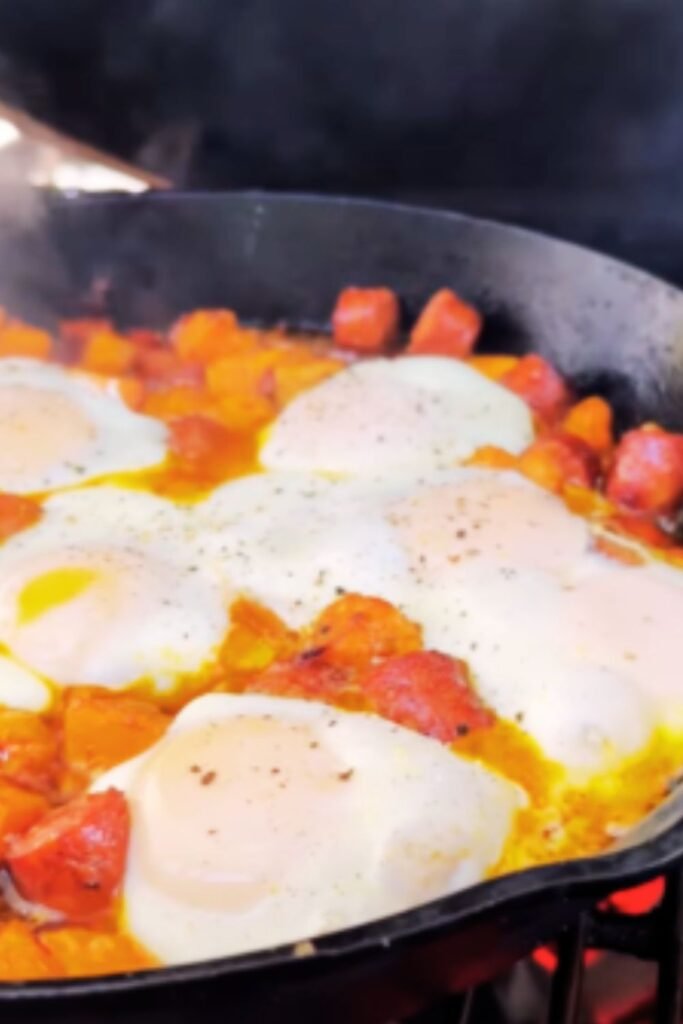
Step-by-Step Cooking Process
Preparing Your Ingredients
Proper prep makes the cooking process smooth and enjoyable:
- Peel sweet potatoes and dice into ½-inch cubes (uniform size ensures even cooking)
- Dice onion and bell pepper into similar-sized pieces
- Mince garlic finely
- Dice chorizo into ¼-inch pieces
- Chop herbs and set aside for garnish
- Crack eggs into a small bowl for easy access when needed
Cooking the Skillet
- Preheat your skillet: Place your cast iron skillet over medium heat and add olive oil, allowing it to heat until shimmering but not smoking.
- Cook the chorizo: Add diced chorizo to the hot skillet and cook for about 3-4 minutes until it releases its oils and begins to crisp. The fat from the chorizo will infuse the entire dish with flavor.
- Add the sweet potatoes: Once the chorizo has rendered some fat, add the diced sweet potatoes to the skillet. Stir to coat with the flavorful oil, then spread into an even layer. Cook undisturbed for 3-4 minutes to develop a nice crust, then stir and continue cooking for another 8-10 minutes until the potatoes are tender when pierced with a fork.
- Incorporate the aromatics: Add the diced onion and bell pepper to the skillet. Cook for 3-4 minutes until the vegetables begin to soften. Add the minced garlic, smoked paprika, cumin, and red pepper flakes. Cook for an additional 1 minute until fragrant.
- Create wells for the eggs: Using your wooden spoon, create 6 wells in the mixture. Crack an egg into each well, being careful not to break the yolks.
- Cook the eggs: Cover the skillet with a lid or foil and reduce heat to medium-low. Cook for 5-6 minutes for runny yolks, or 7-8 minutes for more set yolks. The whites should be completely set but the yolks still slightly soft for the optimal experience.
- Season and garnish: Remove from heat, season the eggs with salt and pepper, and sprinkle with fresh thyme, cilantro, and green onions.
Pro Tips for Perfect Results
- Don’t crowd the pan: Give your sweet potatoes room to breathe and develop a crispy exterior. If needed, cook in batches.
- Watch the heat: Cast iron retains heat extremely well. If your skillet gets too hot, remove it from the heat briefly to regulate temperature.
- Season as you go: Add salt at each stage rather than just at the end. This builds layers of flavor throughout the dish.
- Cover technique: When cooking the eggs, a clear glass lid allows you to monitor progress without losing heat.
Troubleshooting Common Issues
| Problem | Possible Cause | Solution |
|---|---|---|
| Sweet potatoes still hard | Pieces too large or insufficient cooking time | Cut potatoes smaller next time; add 2 tbsp water and cover for 2-3 minutes to steam |
| Eggs overcooked | Heat too high or cooked too long | Lower heat and reduce cooking time; watch eggs closely |
| Dish too dry | Insufficient fat or overcooked | Add a tablespoon of olive oil or water to rehydrate |
| Too spicy | Very hot chorizo variety used | Balance with a dollop of Greek yogurt or sour cream when serving |
| Sticking to pan | Pan not properly seasoned or too high heat | Ensure pan is well-seasoned; use sufficient oil and moderate heat |
Nutritional Information
This skillet isn’t just delicious—it’s nutritionally balanced as well:
| Nutrient | Amount per Serving | % Daily Value |
|---|---|---|
| Calories | 425 | – |
| Protein | 22g | 44% |
| Carbohydrates | 28g | 9% |
| Dietary Fiber | 5g | 18% |
| Sugars | 7g | – |
| Fat | 26g | 33% |
| Saturated Fat | 8g | 40% |
| Cholesterol | 335mg | 112% |
| Sodium | 650mg | 28% |
| Vitamin A | 18,000 IU | 360% |
| Vitamin C | 45mg | 50% |
| Calcium | 80mg | 8% |
| Iron | 3.5mg | 19% |
Values are approximate and based on using Spanish chorizo. Nutritional content may vary based on specific ingredients used.
Serving Suggestions
The beauty of this skillet is that it stands perfectly well on its own, but here are some delicious accompaniments:
- Fresh Garnishes: A few slices of ripe avocado, a squeeze of lime juice, and a sprinkle of flaky sea salt elevate the dish with minimal effort
- Cooling Element: A dollop of tangy Greek yogurt or sour cream balances the heat from the chorizo
- Warm Tortillas: Flour or corn tortillas heated briefly over an open flame are perfect for scooping up every last bite
- Simple Green Salad: A light arugula salad dressed with lemon and olive oil provides a refreshing contrast
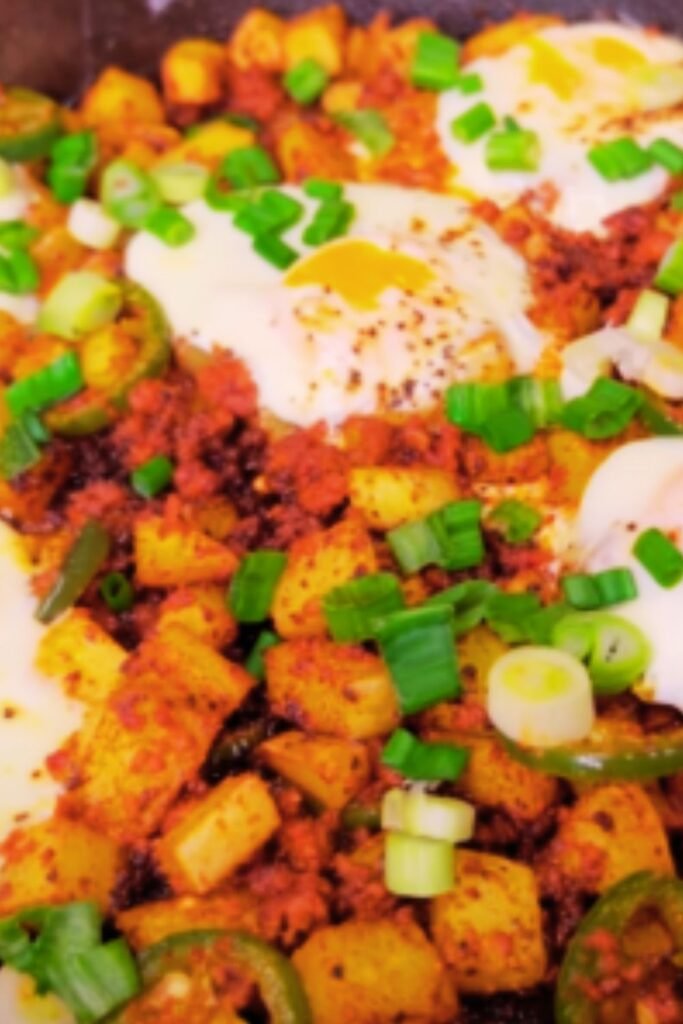
Make-Ahead and Storage Tips
While this dish is best enjoyed fresh, there are ways to prep ahead and store leftovers:
Prep-Ahead Options:
- Dice sweet potatoes, onions, and peppers up to 2 days in advance. Store in airtight containers in the refrigerator.
- Measure and mix dry spices in a small container.
- Chop herbs the morning of, storing in a damp paper towel in the refrigerator.
Storage Solutions:
- Refrigeration: Leftovers can be stored in an airtight container for up to 3 days. The eggs will continue to cook when reheated, so consider undercooking them slightly if you know you’ll have leftovers.
- Freezing: Not recommended for the complete dish as the eggs don’t freeze well. However, the sweet potato and chorizo base (without eggs) freezes beautifully for up to 2 months.
- Reheating: Warm gently in a skillet over medium-low heat with a splash of water or broth to rehydrate. Cover to steam and prevent drying out.
Recipe Variations
Don’t have all the ingredients? No problem! This recipe is endlessly adaptable:
Vegetarian Version
Replace chorizo with:
- 8 oz firm tofu, crumbled and sautéed with 1 tablespoon smoked paprika, ½ teaspoon garlic powder, and ¼ teaspoon cayenne
- OR 1 cup black beans, drained and rinsed
Different Potato Options
- Regular russet potatoes work well but need slightly longer cooking time
- Red potatoes can be used with skins on for added texture
- For a lower-carb version, substitute cauliflower florets (reduce cooking time by half)
Seasonal Adaptations
- Spring: Add asparagus tips and peas during the last few minutes of cooking
- Summer: Incorporate diced zucchini and fresh corn kernels
- Fall: Include diced butternut squash alongside or in place of sweet potatoes
- Winter: Add hearty greens like kale or Swiss chard
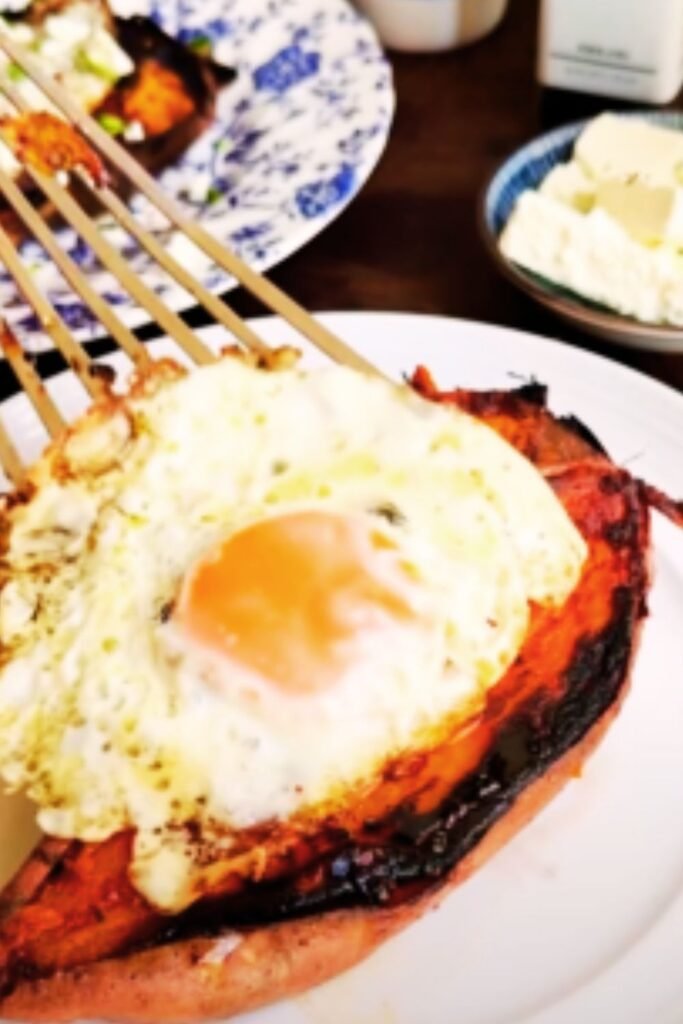
Why This Recipe Works: The Science Behind the Skillet
Understanding a few culinary principles helps explain why this recipe creates such a perfect harmony of flavors and textures:
The Maillard Reaction
When the sweet potatoes and chorizo brown in the hot skillet, they undergo what’s called the Maillard reaction—a chemical reaction between amino acids and reducing sugars that gives browned food its distinctive flavor. This is why it’s important not to crowd the pan and to let those potatoes develop a nice crust.
Fat-Soluble Flavors
Many of the compounds that give spices their distinctive flavors are fat-soluble, meaning they release more fully in oil than in water. By blooming the spices in the chorizo fat, we’re maximizing their flavor potential.
Steam-Basting Eggs
When we cover the skillet to cook the eggs, we’re using steam to cook the tops while the bottoms cook from direct contact with the pan. This gentle method prevents the bottoms from becoming rubbery before the tops set.
Frequently Asked Questions
Q: Can I use Mexican chorizo instead of Spanish chorizo?
Yes, absolutely! Just note that Mexican chorizo is raw and needs to be fully cooked, while Spanish chorizo is cured. If using Mexican chorizo, remove it from any casing and cook it fully before adding the sweet potatoes.
Q: How can I tell when my sweet potatoes are perfectly cooked?
Sweet potatoes should be tender when pierced with a fork but still hold their shape. If they’re falling apart, they’ve cooked too long. Ideally, they’ll have crispy edges and soft centers.
Q: Is there a way to make this dish ahead for a brunch party?
You can prepare everything up to the point of adding the eggs. When guests arrive, reheat the skillet, create wells, add the eggs, and finish cooking. This ensures fresh, perfectly cooked eggs.
Q: My cast iron skillet isn’t well-seasoned yet. Will this recipe work in a different pan?
Yes! A heavy-bottomed stainless steel or non-stick skillet will work too. Just ensure it’s oven-safe if you choose to finish the eggs in the oven rather than on the stovetop.
Q: Can I double this recipe?
For best results, use two skillets rather than trying to fit everything in one. Overcrowding prevents proper browning and texture development.
Q: My family doesn’t like runny eggs. Can I make this with fully cooked yolks?
Absolutely! Simply increase the covered cooking time by 3-4 minutes, or until the yolks are set to your liking. You could also scramble the eggs and fold them into the mixture if preferred.
The Story Behind This Dish
I developed this recipe during a particularly challenging winter when comfort food became essential for brightening dark mornings. Inspired by traditional Spanish and Mexican breakfast dishes, I wanted something that delivered maximum flavor with minimum effort.
The chorizo brings a touch of Spain, while the sweet potato-egg combination pays homage to Mexican breakfast traditions. It’s truly a global dish that feels simultaneously exotic and familiar. What began as an experiment has become one of my signature recipes, requested whenever friends stay over for the weekend.
There’s something deeply satisfying about sharing a communal skillet at the table—everyone diving in with their forks, finding their favorite bites. It creates not just a meal but a moment of connection. And isn’t that what good food is all about?
Next time you’re looking to elevate your breakfast game beyond the ordinary, give this Chorizo & Sweet Potato Egg Skillet a try. It might just become your new weekend tradition too.
Final Chef’s Notes
A few parting thoughts before you heat your skillet:
- Quality ingredients matter here—especially the chorizo and eggs. Seek out a good Spanish chorizo with visible fat marbling for the best flavor.
- Don’t rush the cooking process. Those few extra minutes developing flavor at each stage make all the difference.
- Make this recipe your own. The framework is solid, but feel free to adapt based on your preferences and what’s in season.
- Gather everyone around the table while the skillet is still sizzling—there’s something magical about that moment when the aromas hit and the eggs are perfectly set.
Happy cooking!
